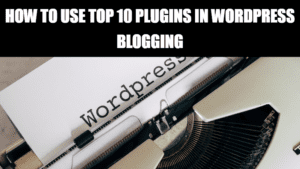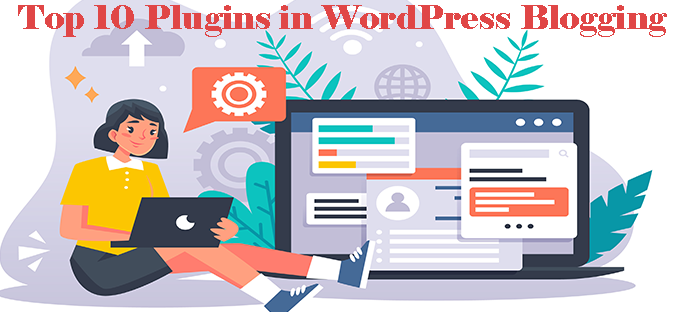Introduction
WordPress is a powerful platform that enables people and companies to share their experiences and Boost Their Blog with the Top 10 Plugins in WordPress Blogging ideas with the world in the constantly changing world of blogging. How does your WordPress blog advance, though? The power of plugins holds the solution. These software add-ons provide a wide range of features that improve the functionality, usability, and overall success of your blog. In this thorough guide, we’ll look into the best 10 WordPress blogging plugins that may boost your website’s performance, engage your followers, and advance your writing career.
What is a Plugin

The fundamental functionality of WordPress is extended through plugins, which are collections of code. Plugins for WordPress are composed of PHP code and may also contain assets like photos, CSS, and JavaScript.
You are expanding WordPress by creating your own plugins, i.e., adding new functionality on top of what WordPress currently provides. You might create a plugin, for instance, that connects to the top 10 plugins in WordPress blogging’s most recent blog entries on your website.
You might also develop a plugin that generates a fully functional support ticketing system with email notifications, configurable ticket statuses, and a client-facing portal utilising WordPress’ custom post types. The options are limitless!
A plugin actually only needs one primary file with a specially structured DocBlock in the header. While the majority of WordPress plugins are made up of several files, this is not always necessary.
Only 100 lines make up Hello Dolly, one of the original plugins. In the WordPress admin, a message called Hello Dolly displays music lyrics. To regulate how the lyric is styled, some CSS is utilised in the PHP code.
You have a fantastic chance as a WordPress.org plugin author to develop a plugin that will be used, modified, and adored by millions of WordPress users. Just write your brilliant concept in code, that’s all. Your resource for doing such is the Plugin Handbook.
How to Use Top 10 plugins in WordPress blogging

The top 10 plugins in WordPress blogging may be added to your website in a variety of ways. You might accomplish this, for instance, through your dashboard, the official WordPress plugin directory, or outside websites. While some premium plugins need to be manually installed using an FTP client, plugins from the official directory may be installed automatically with only one click.
You only need to log into your dashboard and choose Plugins > Add New to install a plugin from the official WordPress directory. Then utilise the built-in search box to look for the plugin. You only need to click Install and Activate after that.
Let’s refer back to the plugin example from earlier to learn how to install a plugin that isn’t listed in the official directory. If the “Thank you for reading! the plugin is not present in the directory, you should download it as a zip file and save it using an FTP client in the directory’s wp-content/plugins folder. The plugin would be installed on your WordPress website automatically as a result.
Next, you would go to the Plugins section of your admin dashboard. You only need to click the “Activate” link on the plugin once you’ve found it in the list of installed plugins on your website. After that, the phrase “Thanks for reading! would be added automatically at the end of every post you made.
Although most plugins start operating right immediately, you might need to adjust their settings to make sure they’re functioning as you want them to. You would have to go to the plugin’s settings page and choose Create New Staging Site, for instance, if you were using the WP Staging – DB & File Duplicator & Migration plugin to create a WordPress staging site. Next, provide some data, such as the name of the staging site and the material you want replicated. The plugin wouldn’t automatically set up a staging site if it didn’t.
If all of this seems like a lot of work, you may be asking why people don’t just alter the core WordPress files and add functionality to their websites. That’s because any changes made to the core files are erased when updating to a new version of WordPress.
You’d need to return and make further edits to the core files in order to add that capability to your revised website. You only need to worry about keeping the plugins updated if you install plugins to provide your site with more functionality.
Let’s look at some plugins that can add crucial functionality to your WordPress site now that we understand what plugins are, how they function, and how to utilise them.
Enhancing Your Blogging Experience with Plugins
The key ingredient that turns WordPress become the adaptable platform it is today is plugins. The options are unlimited with more than 58,000 plugins accessible in the official WordPress plugin repository. Plugins provide a programmable toolbox that may meet your unique blogging needs, from increasing website performance to upgrading security, managing comments, and improving SEO.
Boost Your Blog with the Top 10 Plugins in WordPress Blogging – Video Tutorial For You:
NOTE– “Top 10 plugins in WordPress blogging “all these plugins are available for free”
Top 10 Plugins in WordPress Blogging -so install all plugins
1. Yoast SEO: Mastering Search Engine Optimization
Without including Yoast SEO, no list of the best plugins for WordPress blogging is complete. By assisting you in making your content search engine-friendly, this plugin serves as your own personal SEO helper. Yoast SEO helps you increase your chances of ranking better in search engine results with tools like content analysis, readability tests, and metadata optimisation.
2. Easy Table of Contents Plugin
A user-friendly, featured-focused Easy Table of Contents plugin which allows you to insert a table of contents into your posts, pages and custom post types.
3. W3 Total Cache: Accelerating Website Speed
High bounce rates and a bad user experience can result from slow-loading websites. By caching elements, lowering load times, and improving overall speed, W3 Total Cache optimises the performance of your website, which may have a favourable effect on your search engine results.
4. UpdraftPlus: Safeguarding Your Content
It is critical to safeguard your labour of love. The complete backup plugin UpdraftPlus makes sure that all of your blog’s settings, themes, and content are securely backed up. You may feel confident knowing that your blog is protected thanks to periodic backups and simple restoration options.
5. WPForms: Crafting User-Friendly Contact Forms
It’s crucial to interact with your readers, and WPForms makes it easy to do. You may create and embed contact forms, polls, and even payment forms on your blog thanks to its user-friendly interface. Engage your audience in conversation to easily obtain insightful information.
6. AddToAny Share Buttons
The AddToAny Share Buttons for WordPress plugin helps visitors share your articles and pages to any service, which boosts traffic and engagement. Facebook, Twitter, Pinterest, WhatsApp, LinkedIn, Tumblr, Reddit, WeChat, and more than 100 more social networking and sharing websites & applications are among the services offered.
7. OneSignal Push Notifications
OneSignal makes it simple to boost user engagement. Send tailored push alerts to visitors with OneSignal to encourage them to return. Installation only takes a few minutes. OneSignal has undergone extensive testing as a WordPress VIP Gold Partner to handle even the highest traffic use cases with dependability and simplicity.
8. Site Kit by Google
The official WordPress plugin from Google providing insights into how users locate and utilise your site is called Site Kit. The all-in-one solution for deploying, managing, and gaining insights from vital Google technologies is called Site Kit, and it is essential to the online success of the site. Directly on the WordPress dashboard, it offers simple access to reliable, current insights from many Google products.
9. Smush: Reduce image file sizes
With the highly powerful and totally free WordPress image smush, offered to you by the superteam at WPMU DEV, you can optimise pictures, enable lazy load, resize, compress, and enhance your Google Page Speed! Additionally, Smush will compress photographs without a discernible loss in quality, regardless of how you type the word.
10. Web Stories
You can quickly build visual narratives with captivating animations and tappable interactivity with Web Stories, a free, open-web, visual storytelling format for the web. Web Stories immerse your readers in fantastic and quick-loading full-screen experiences.
Conclusion:
The top 10 plugins in WordPress blogging are your friends in building an alluring, effective, and safe online presence as you start your blogging adventure. These plugins provide a wide range of options, from improving your design to securing your data and search engine-optimizing your content.
Remember that compatibility and moderation are the keys to effective plugin usage. Select plugins that support your objectives, and make sure they integrate well to prevent conflicts. To keep your site operating effectively, update your plugins on a regular basis and remain up to speed with new advancements.
With the help of these top 10 plugins in WordPress blogging, you can use your WordPress site to create a dynamic, interesting, and high-performing platform that enthrals visitors and aids in your blogging goals. So go ahead and use the magic of plugins to increase your blog and watch as your internet presence soars to new heights.
If You Like The Post, Then Comment And Share.
Thank You
